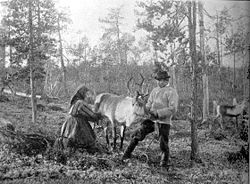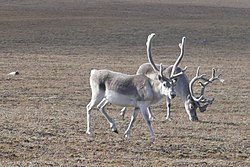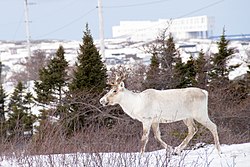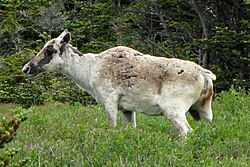Reindeer
The reindeer (Rangifer tarandus) is an even-toed ungulate mammal of the deer family. In North America it is also called caribou. There are about 10-20 reindeer subspecies. The reindeer is the only deer that has been domesticated.
| Rangifer | |
|---|---|
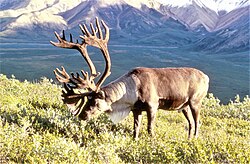
| |
| A reindeer | |
| Conservation status | |
| Scientific classification | |
| Kingdom: | |
| Phylum: | |
| Class: | |
| Order: | |
| Family: | |
| Subfamily: | |
| Genus: | Rangifer
|
| Binomial name | |
| Rangifer tarandus (Linnaeus, 1758)
| |

| |
| Reindeer map | |

Appearance
The different reindeer subspecies have different sizes and slightly same fur colors. Male reindeer are usually bigger and heavier than the females. Reindeer are about 1.20 - 2.20 meters long and about 0.90 - 1.40 meters high. They weigh between 60 - 300 kilograms. Reindeer mostly have a grey-brown fur. The fur is dark in summer and becomes a lighter color in winter. Reindeer have big feet that help them walk on soft ground.
North American Caribou and Eurasian Reindeer are the same species, but there are some noticeable differences in the subspecies.
Reindeer: - most commonly found as domesticated animals - sedentary - breeding starts mid-Aug - can be pinto colored - dark brown calves - more fat - thicker fur - shorter face and muzzle - males have larger antlers than female caribou
Caribou:
- wild - migratory - breeding starts mid-September - never pinto colored light brown calves
Antlers
Reindeer are the only deer where both sexes have antlers. The antlers of female reindeer are smaller than the antlers of males.
"The antlers start growing in April and are fully developed by Autumn"; "reindeers shed their antlers, the bucks just before Christmas and the females later in the spring".[1] "On a large buck, the antlers can grow up to a centimeter a day".[1]
Range
Reindeer can be found in Sápmi (Northern Finland, Sweden, Norway and Russia), North America (All over Canada and on farms across North America where they are raised in captivity), and Siberia. They were first used by people to do work in Sápmi and Siberia.
Habitat
Reindeer live in coniferous forest and Arctic conditions. The historic range of the reindeer is threatened by global warming.[2]
Life
Reindeer are herd animals and live in groups. They live in groups of 10-100 reindeer, which are herds of only females or herds of only males. Reindeer go on long journeys between the warm and cold seasons. For this journeys the smaller groups form big herds of up to several 100,000 animals. Reindeer mate in October, and the males mate with as many females as possible.
Feeding habits
Reindeer eat mostly grass, but eat also almost any other plant. In winter they often eat lichen,[1] moss and fungi. "During winter, they find lichen by using their hooves to get under the snow"
Health
Pregnancy
After a pregnancy of 230 days the female gives birth to a single baby, usually in May or June. Reindeer babies do not have spots on their fur, like most other deer babies have. Young reindeer become mature when they are 2 year old. Reindeer usually live to be 12–15 years old, sometimes they can live to be 20 years old.
Heat stroke
"During early spring when the daytime temperature rises and they have not yet shed their fur or winter coats", they "sometimes ... get heat stroke".[1]
Reindeer and humans
Reindeer have been hunted by humans since the stone age. People, especially in the northern regions, used the reindeer's meat, fur, skin, antlers and bones.
The reindeer was domesticated about 3 thousand years ago. It was first domesticated in Siberia and Scandinavia. Since then, reindeer have also been used for transport, for example for pulling sleds. Because reindeer can live in very cold climates, domesticated reindeer are used in most northern parts of the world.
Among the ethnic groups that use reindeer - for fur, and food - are the Sámi in Sápmi.
In popular culture
In western/European culture, it is said that Santa Claus' sled is pulled by reindeer.
Reindeer Media
References
- ↑ 1.0 1.1 1.2 1.3 Gunnar Gran. "Reindeer Farming - a Plus for Norway". March 2002; number 2. The Norseman. pp. 13-7
- ↑ Caribou face major threat from climate change, study finds; Historic habitat could shrink by 90 per cent by 2070 Archived 2019-01-26 at the Wayback Machine 15.Dec.2013 Calgary Herald
| Wikispecies has information on: Rangifer. |
| Wikimedia Commons has media related to Lua error in Module:Commons_link at line 62: attempt to index field 'wikibase' (a nil value).. |



